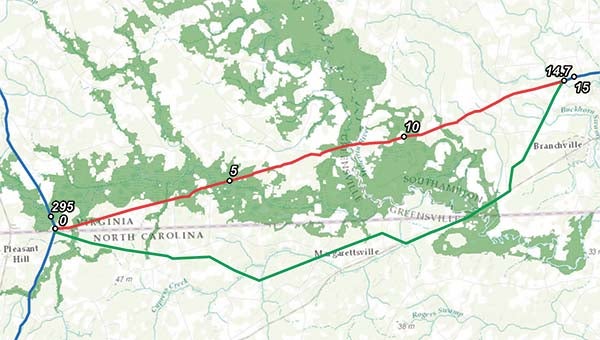SoCo can have access to pipeline
Published 2:01 pm Saturday, January 31, 2015

This map shows the route of the proposed Atlantic Coast Pipeline. The blue vertical line shows the path from West Virginia into North Carolina. The lateral red line is the Meherrin River baseline, and the green is the alternative route. — SUBMITTED
FRANKLIN
Although the proposed natural gas Atlantic Coast Pipeline is far from being approved, officials with the project have given assurances that Southampton County can have access to an available percentage of natural gas for economic development.
Almost three weeks ago, The Tidewater News sat down with officials from Dominion Resources, one of the four companies involved with the 550-mile project. Included in the conversation were Chet Wade, vice president of corporate communications, and Max Bartholomew, manager of Eastern Regional state and local affairs; and Bonita Harris, vice president of communications; Tony Clark, publisher of The Tidewater News; staff writer Andrew Lind and also this reporter.
While the Dominion representatives had an opportunity to give an update on the pipeline, the newspaper’s chief concerns were: What steps does Southampton County have to take in order to tap into line, and what are the guarantees that can happen?
“Taps are put in once you identify those customers,” Wade said. “We’d like to put in the off-ramp now.”
He added that — as an example — it could cost $1 million now to do so, but later a little more at $1.5 million. Wade also said that Bryan Smith, economic development manager, could have more exact numbers later.
“We would work with potential customers to bring a proposal,” Bartholomew said. “Some counties are getting together as a regional authority.”
But these answers didn’t satisfy the newspaper, so we were referred to speak with Smith.
“The first step is to approach the Local Distribution Company, which is Columbia,” he said. “They have to make an evaluation.”
Smith then recommended speaking with Robert Innes, director of communications and community relations for Columbia Gas of Virginia.
“As we learn more about the pipeline and what the capacity is in the pipeline, we’d be sitting down with the communities that the pipeline goes through,” Innes said. “We’d find out what they’d like to see, and then approach the pipeline consortium.”
He wanted to stress that there’s not a “cookie-cutter” approach, adding, “It depends on circumstance, community, the needs, what the community’s ‘ask’ is.”
In a follow-up email, Innes stated: “…if the proposed pipeline is approved and ultimately a route is confirmed then we — Columbia Gas of Virginia — will have a better understanding of the relation between our existing distribution facilities and the proposed pipeline.
“However, Columbia Gas of Virginia is always looking to expand our existing customer base and distribution system into markets which are supported by sound economic evaluation. The company is always open to discuss with interested parties about economic development opportunities today and in the future.”
To ensure accuracy and understand, the newspaper had a conference call on Jan. 26 with Bartholomew, Smith, as well as Lyle Henry, manager of gas development, and Amanda Jarrett, the president and CEO of the Franklin-Southampton Economic Development Inc.
The newspaper again asked if the pipeline is available to Southampton County and what’s the process.
Smith first reiterated his earlier points.
“You can have direct access,” he said. “First call the Local Distribution Company — Columbia — and see what they have in the ground and what they can do for you. For example, Amanda has a desired site, and Columbia says $1 million would be the cost. But that number may change.
“If you don’t have a customer, say you’re marketing an industrial park without a prospect, you’d be paying for a route. I don’t think anyone’s going to build a pipeline without a client.”
He added that Jarrett can ask hypothetically about getting natural gas to different sites, and Columbia could give estimates. Then prospective companies can see what it will cost.
“Several prospects have been lost for a lack of gas,” Smith said.
Henry said that for an interstate pipeline, any customers can ask for a tap, but noted there are different types of requests. There’s firm capacity, which means the product is available anytime. Or interruptible capacity, which allows a customer to arrange for pre-arranged set times or amounts.
“Until you have an authorized customer, you’re not going to get a tap,” Smith said in support.
Jarrett said FSEDI is “constantly doing such research for potential clients. At Pretlow [Industrial Park], I have cost estimates. I always double-check facts and figures.”
Jarrett and Smith were also asked if they could imagine a project too big for the pipeline, and both said no.
“More compression can be put on the pipeline and there’s not a finite number at this point,” he said.
And in conclusion, Smith also stated, “Yes, you can get access [to the Atlantic Coast Pipeline], and you can market it.”





